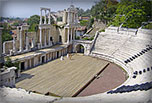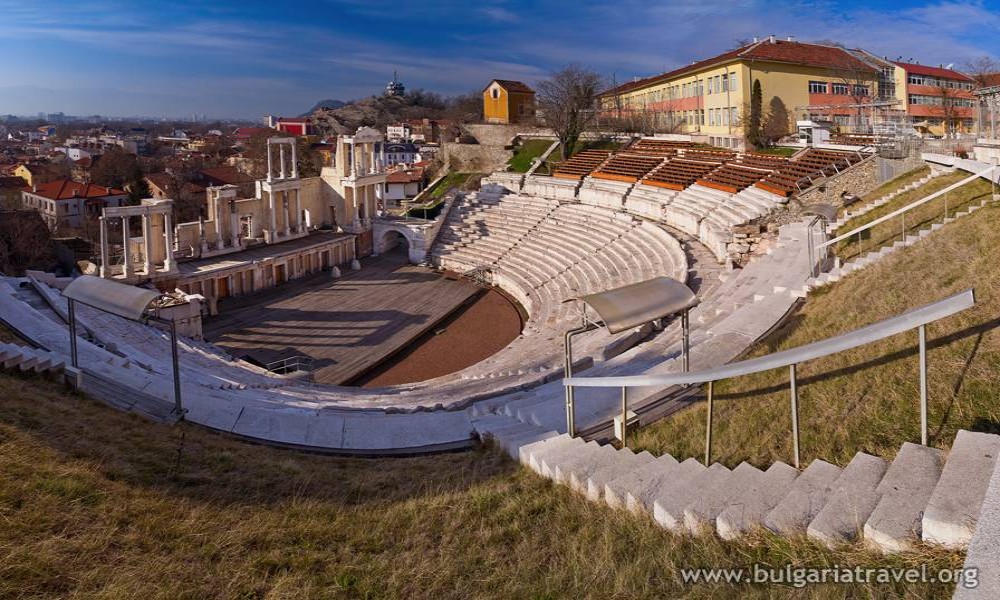History
Plovdiv has settlement traces dating from the Neolithic, roughly 4000 BC. Archaeologists have discovered fine pottery and other objects of everyday life from as early as the Neolithic Age, showing that in the end of the 4th millennium B.C. there already was an established settlement there. According to Ammianus Marcellinus, Plovdiv's written post-Bronze Age history lists it as a Thracian fortified settlement named Eumolpias. In 4th century BC the city was a centre of a trade fair (called panegyreis). In 342 BC, it was conquered by Philip II of Macedon, the father of Alexander the Great, who renamed it , Philippopolis or "the city of Philip" in his own honour. Later, it was reconquered by the Thracians who called it Pulpudeva(a reconstructed translation of Philipopolis)
In 72 AD it was seized by the Roman general Terentius Varo Lukulus and was incorporated into the Roman Empire, where it was called Trimontium (City of Three Hills) and served as metropolis (capital) of the province of Thrace. It gained a city status in late 1st century.Trimontium was an important crossroad for the Roman Empire and was called "The largest and most beautiful of all cities" by Lucian. Although it was not the capital of the Province of Thrace, the city was the largest and most important centre in the province. In those times, the Via Militaris (or Via Diagonalis), the most important military road in the Balkans, passed through the city.
"This [Plovdiv] is the biggest and loveliest of all cities. Its beauty shines from faraway..."
The Roman times were a period of growth and cultural excellence. The ancient ruins tell a story of a vibrant, growing city with numerous public buildings, shrines, baths, and theatres. The city had an advanced water system and sewerage. It was defended with a double wall. Many of those are still preserved and can be seen by tourists. Today only a small part of the ancient city has been excavated.
Middle Ages
The Slavs had fully settled in the area by the middle of the 6th century and changed the ethnic proportions of the region. With the establishment of Bulgaria in 681 Philipopolis became an important border fortress of the Byzantine Empire. It was captured by Khan Krum in 812 but the region was fully incorporated into the Bulgarian Empire in 834 during the reign of Khan Malamir. It remained in Bulgarian hands for a relatively short time until it was reconquered by the Byzantine Empire in 855-856. Under Byzantine control the city became the centre of Paulician heretics transported from the eastern borders of the empire to serve as military settlers on the European frontier with Bulgaria. From Philippopolis the influence ofdualistic doctrines spread to Bulgaria forming the basis of the Bogomil heresy. Under tsarSimeon the Great (893–927) the city and most of the Byzantine possessions in the Balkans were conquered by the Bulgarian Empire. The city remained in Bulgarian hands under Simeon's son, Peter I (927–969).
In 970 the Asian army of the Byzantine Empire under the eunuch Peter was destroyed by the Bulgarians near Plovdiv. The city again came to be known as Philippopolis and became Byzantine in character. Aime de Varennes in 1180 encountered the singing of Byzantine songs in the city that recounted the deeds of Alexander the great and his predecessors, over 1300 years before.
Byzantine rule was succeeded by that of the Latin Empire in 1204, and there were two short interregnum periods as the city was twice occupied by Kaloyan of Bulgaria before his death in 1207. In 1208 Kaloyan's successor Boril was defeated by the Latins in the Battle of Plovdiv.Under Latin rule, Plovdiv was the capital of the Duchy of Philippopolis governed by Renier de Trit, and later on by Gerard de Strem. Bulgarian rule was reestablished during the reign ofIvan Asen II between 1225 and 1229. In 1263 Plovdiv was conquered by the restoredByzantine Empire and remained in Byzantine hands until it was re-conquered by George Terter II of Bulgaria in 1322. Byzantine rule was restored once again in 1323, but in 1344 the city and eight other cities were surrendered to Bulgaria by the regency for John V Palaiologosas the price for Ivan Alexander of Bulgaria's support in the Byzantine civil war.
In 1364 the Ottoman Turks under Lala Shakhin Pasha seized Plovdiv. The Turks called the city Filibe. It was the capital of Rumelia until 1382 when the Ottomans captured Sofia which became the main city of the province. Plovdiv survived as one of the major cultural centers for Bulgarian culture and tradition. The name Plovdiv first appeared around that time and is derived from the city's Thracian name Pulpudeva (assumed to be a translation of Philippopolis, from Pulpu = Philippou and deva = city), which was rendered by the Slavs first as (Пълдин)
National revival

Under the rule of the Ottoman Empire, Plovdiv was a focal point for the Bulgarian national movement in the Eastern Rumelia province of the Empire. During that period Plovdiv was a major economic center along with Istanbul, Odrin and Solun. The richer citizens constructed beautiful houses many of which can still be seen in the Architectural reserve Old Plovdiv. Plovdiv was a sanjak centre of Rumelia Province between 1364-1864 and was the sanjak centre of Edirne Vilayet between 1864-1878 during Ottoman Rule.
Plovdiv had an important role in the struggle for Church independence which was according to some historians a peaceful bourgeois revolution. Plovdiv became the center of that struggle with leaders such as Nayden Gerov, Dr Valkovich, Joakim Gruev and whole families. In 1836 the first Bulgarian school was inaugurated and in 1850 modern secular education began when the "St Cyrill and Metodius" school was opened. On 11 May 1858 the day of Saints Cyril and Methodius was celebrated for the first time, this later became a National holiday which is still celebrated today. In 1858 in the Church of Virgin Mary the Christmas liturgy was served for the first time in the Bulgarian language since the beginning of the Ottoman occupation. In 1868 the school expanded into the first grammar school. Some of the intellectuals, politicians and spiritual leaders of the nation graduated that school.
The city was liberated from the Ottomans during the Battle of Plovdiv in 1878.
Eastern Rumelia
According to the Treaty of San Stefano on 3 March 1878 the Principality of Bulgaria included the lands with predominantly Bulgarian population. Plovdiv which was the biggest and most vibrant Bulgarian city was selected as a capital of the restored country and for a seat of the Temporary Russian Government. Great Britain and Austria-Hungary, however, did not approve that treaty and the final result of the war was concluded in the Congress of Berlinwhich divided the newly liberated country into several parts. It separated the autonomous region of Eastern Rumelia from Bulgaria and Plovdiv became its capital. The Ottoman Empire created a constitution and appointed a governor. As of 1 January 1885, the city of Plovdiv had a population of 33,442, of which 16,752 were Bulgarians (50%), 7,144 Turks (21%), 5,497Greeks (16%), 2,168 Jews (6%), 1,061 Armenians (3%), 151 Italians, 112 Germans, 112Romani people, 80 French people, 61 Russians and 304 people of other nationalities.
In the spring of 1885 Zahari Stoyanov formed the Secret Bulgarian Central Revolutionary Committee in the city which actively conducted propaganda for the unification of Bulgaria and Eastern Rumelia. On 5 September several hundred armed rebels from Golyamo Konare (nowSaedinenie) marched to Plovdiv. In the night of 5–6 September these men led by Danail Nikolaev took control of the city and removed from office the General-Governor Gavril Krastevich. A provisional government was formed led by Georgi Stranski and universal mobilization was announced. After the Serbs were defeated in the Serbo-Bulgarian War, Bulgaria and Turkey reached an agreement according to which the Principality of Bulgaria and Eastern Rumelia had a common government, Parliament, administration and army. Today 6 September is celebrated as the Unification Day and the Day of Plovdiv.
Recent history
After the unification Plovdiv remained second city in population and significance after the capital Sofia. The first railway in the city was built in 1874 and in 1888 it was linked with Sofia. In 1892 Plovdiv became host of the First Bulgarian Fair with international participation which was succeeded by the International Fair Plovdiv. After the liberation the first brewery was inaugurated in the city.
In the beginning of the 20th century Plovdiv grew as a significant industrial and commercial center with well developed light and food industry. German, French and Belgian capital was invested in the city in development of modern trade, banking and industry. In 1939 there were 16,000 craftsmen and 17,000 workers in manufacturing factories, mainly for food and tobacco processing. During the Second World War the tobacco industry expanded as well as the export of fruit and vegetables. In 1943 1,500 Jews were saved from deportation inconcentration camps by the archbishop of Plovdiv, Cyril, who later became the Bulgarian Patriarch.
On 6 April 1956 the first trolleybus line was opened and in the 1950s the Trimontsium Hotel was constructed. In the 1960s and 1970s there was a construction boom and many of the modern neighborhoods took shape. In the 1970s and 1980s antique remains were excavated and the Old Town was fully restored. In 1990 the Sports complex "Plovdiv" was finished, it included the largest stadium and rowing canal in the country. In that period Plovdiv became the birthplace of Bulgaria's movement for democratic reform, which by 1989 had garnered enough support to enter government.
Plovdiv has hosted specialized exhibitions of the World's Fair in 1981, 1985, and 1991.
by www.wikipedia.org




























